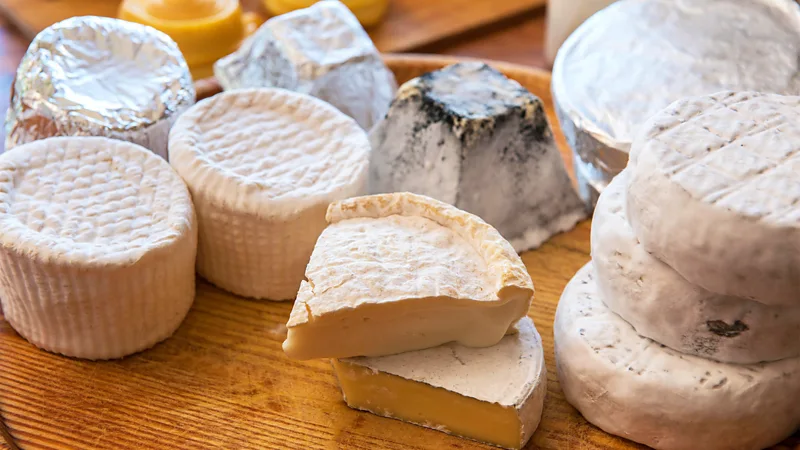Is the future of French cheese at stake?
Earlier this year, cheese fans panicked following the publication of new research on essential cheesemaking moulds, certain the end was nigh for beloved Brie and Camembert.

It was an outsized reaction, according to Jeanne Ropars, the co-author of the very study that made such noise in the first place. "I must emphasise that there is no production problem, in the short term, for cheeses," she said. "Even for Camembert."
That said, the news did provide an opportunity to examine the cheesescape at large, where certain beloved creations are indeed endangered.
The worries about Camembert's future arose following the publication of a brief penned by Ropars and Tatiana Giraud, research director at the CNRS (The French National Centre for Scientific Research), regarding a newly discovered population of Penicillium roqueforti, the mould that gives blue cheese its azure veins. The researchers took advantage of the discovery to highlight a "drastic loss of diversity" in cheesemaking ferments, notably citing their own 2020 research on genetic degradation of moulds populating Camembert's rind, which, to be fair, have been doomed for more than a century.
Camembert and its bloomy cousins like French Brie, English Baron Bigod and American Mt Tam get their white, mushroom-scented exteriors from just one strain of mould, Penicillium camemberti var camemberti, an albino mutant isolated in 1897 in the Brie region from a panoply of such fungi that had long proliferated in ageing cellars. In sprinkling this mutant mould onto the sterilised surfaces of their cheese, cheesemakers supplanted the colourful rinds' variety of moulds and bacteria ranging from red to blue to green to grey with pure, downy white.
[People] preferred a beautiful white cheese with pretty down, as opposed to a cheese that looked a bit mouldy - Arnaud Sperat-Czar
"The market demanded it," said Arnaud Sperat-Czar, president of the Fondation pour la Biodiversité Fromagère. "[People] preferred a beautiful white cheese with pretty down, as opposed to a cheese that looked a bit mouldy."
This desire for homogeneity, however, has come at a cost. Today, all Penicillium camemberti var camemberti is cloned from that same mutant spore, making it incapable of sexual reproduction. "Naturally," said Ropars. "You can't cross an individual with its clone."
This lack of genetic diversity means the spore is unable to evolve and adapt, the crux of the issue that led to the brouhaha seeming to signal Camembert's demise. But the problem isn't without solutions, especially if the cheese world is willing to sacrifice some of that long sought-after uniformity. After all, Penicillium camemberti var camemberti is far from the only mould that gives rise to a bloomy rind. P camemberti v caseifulvum, according to Ropars, is a genetically similar strain, albeit with a slightly less fluffy texture; and its once-common relative, P biforme, which boasts a diversity in colour ranging from white to blue-grey, could be used as is for a more diverse colour palette, or re-isolated to encourage the pale colour we've become used to. And there's no rush to decide.
"There are so many producers, and so many parent strains, that no one, at the end of the day, is worried about the end of Camembert," said Sperat-Czar.
Cheesemaker Pierre Coulon, founder of La Laiterie de Camembert, agrees. "It's really just the buzz effect, as usual," he said. "That's not what's going to make cheese disappear."
But other issues might.
In Normandy, Coulon said, "it's been raining since July," and even in this famously damp region, humidity is posing unprecedented problems, from a proliferation of new, unsought-after moulds on his Camemberts to ground so waterlogged that cows can't be put out to pasture.
In other regions, climate change has given rise to such dry summers that not only are milk yields dropping, according to Profession Fromager, but the texture and flavour of the finished product is changing. Hot weather can lead to a degradation in the very quality of an animal's milk, with lower casein and mineral contents that make it more difficult to make good cheese.
In Switzerland, warming temperatures have led to local purple mountain saxifrage being supplanted with plant species more common in the Mediterranean, according to Université de Lausanne's l'Uniscope, diminishing the intense, savoury aroma that high-altitude Étivaz cheese was once known for.
And central France's Salers and Grand Aubrac are at risk of disappearing entirely. Much like Champagne, 46 French cheeses sport an Appellation d'Origine Protégée label. Each AOP is governed by a charter established by local producers dictating its means of production. "An AOP is, at its heart, about its connection, a product's connection to place, its history," explained cheese educator Sue Sturman.
An AOP is, at its heart, about its connection, a product's connection to place, its history - Sue Sturman
To wit, both Auvergnat Salers and Aveyronnais Grand Aubrac are traditionally made in summer, when cows can graze on high-mountain pastures. But unseasonable dryness last summer forced farmers to supplement their cattle's feed with hay and thus to temporarily cease making these cheeses in favour of the Laguiole and Cantal typically made in the winter, both of which fetch a lower price.
The producers behind some AOPs are currently at work to modify their charters to account for these changing conditions. "It's about adapting," said Yves Soulhol, managing director of Laguiole's Jeune Montagne cooperative. "It's not complicated, but it demands adaptation."
But other regulations are harder to get around, especially those that come from further afield. Producers of raw milk cheeses are facing ever stricter regulations from the EU, especially as the scientific ability to detect STECs (Shigatoxigenic E coli) becomes more reliable, according to Soulhol. In France, he said, "we're lucky – people like raw milk. But on European and worldwide levels, excuse my rudeness, but it's a pain in the arse."
Some regulations also pose a threat to traditional cheesemaking methods. Last year, proposed European legislation that would have supplanted traditional wooden cheese packaging in favour of more recyclable materials risked sounding a death knell for the very flavours of Jurassian Mont d'Or or Savoyard Manigodine, which glean their distinct aromas from being aged in direct contact with bands of spruce.
While this legislation was ultimately voted down by the European parliament, other measures threaten Saint-Nectaire, an Auvergnat cheese traditionally aged in caves forged in volcanic magma that, according to producer Caroline Borrel, have naturally become naturally rich in the exact mould spores they need to age the cheeses to perfection. But hygiene norms that Borrel characterises as "ever-more constraining" point to potential loss of these methods. Traditional wooden Saint-Nectaire moulds are already forbidden to cheesemakers, and according to Borrel, "They're doing whatever they can to incite us to reduce the use of natural cellars."
Producers, Borrel said, "are collapsing under the weight of the norms and obligations". Some are shedding their AOPs – despite the higher price point the label fetches. Others are leaving the industry entirely. And due to "constant and continual" checks and mountains of paperwork that turn an already full-time job into an impossibility, "the biggest factor threatening the future of Saint-Nectaire and other cheeses is the constant decline of people to take over", she said.
And this, according to Sturman, "is true right across every sector in farming in France."
"Farmers have the highest suicide rate of any population," she said. "It is incredibly difficult to live as a farmer. It is incredibly difficult to make ends meet as a farmer. It is a seven-day-a-week job."
As a result, said Sperat-Czar, "many farms have closed, and others will, because there's no one to take over."
But in recent years, a slew of young people have abandoned urban centres and careers in insurance or banking to work in food-related sectors. Sperat-Czar has seen this in cheese distribution and has high hopes it will trickle into the production side too. With Fondation du Lait Cru, he is launching a project to help support those looking to transition into the sector, matching them up with farms and offering courses via distance learning to complement the on-the-ground training.
"To all these people who are asking questions about their future and their role in society," he said, "we're going to tell them there are farms to take over. There are production facilities where they can work to make traditional products, terroir-driven products, raw milk products."
With help from this young generation, there may still be hope for the future of French fromage.
-BBC







